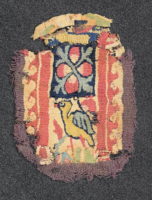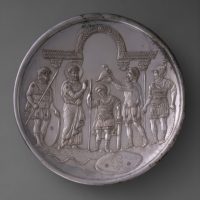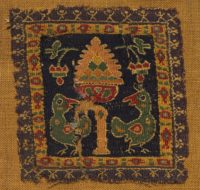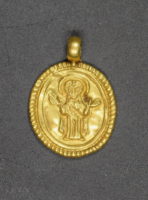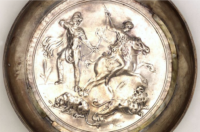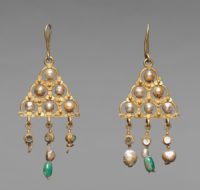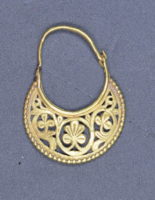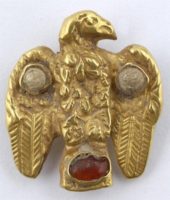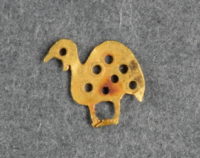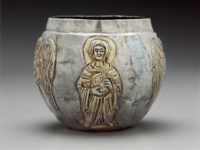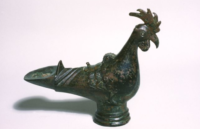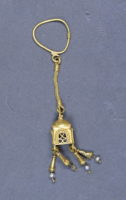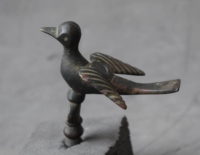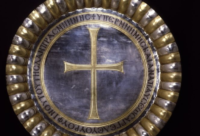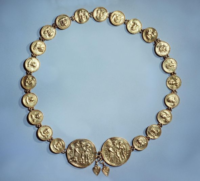Cross, with a decorative quatrefoil rosette at the juncture of the arms. Materials: gold. Period: Early Byzantine; circa: Early 7th c. The Benaki Museum of Greek Culture is housed in one of the most beautiful neoclassical-style buildings in Athens, near the National Garden and the Hellenic Parliament.
[xyz-ihs snippet="Benaki-Hotels"]Piece of woollen coptic textile, Period: Early Byzantine. circa: 6th century-8th century. Height: 90 millimetres (max) Width: 63 millimetres (max). British Museum is closed 24, 25 and 26 December and 1 January, but is open every other day of the year. Fast facts about the British Museum: Founded: 1753, Collection size: 8 million objects, Oldest object in the collection: Stone chopping tool (nearly 2 million years old).
Double Costmetic Tube (balsamarium). Period: Early Byzantine, circa: 5th–6th century A.D. Dimensions: Height: 11.6 cm (4 9/16 in.) Material: Glass. The MFA is open 7 days a week. Monday and Tuesday 10 am–5 pm, Wednesday–Friday 10 am–10 pm, Saturday and Sunday 10 am–5 pm.
Plate with the Arming of David, Period: Early Byzantine, circa: 629–630, Material: Silver, Made in Constantinople. On view at The Met Fifth Avenue in Gallery 301. The Metropolitan Museum of Art (New York) is one of the world’s largest and finest art museums. Its collection includes more than two million works of art spanning five thousand years of world culture, from prehistory to the present and from every part of the globe. Public Hours: 10:30 a.m.–5:30 p.m. Open seven days a week.
Square Segmentum with Two Birds, Period: Early Byzantine; circa: 400s – 500s; Made in: Egypt, Material: tapestry; linen and wool. Dimensions: Overall: 10 x 10 cm (3 7/8 x 3 7/8 in.). The Cleveland Art Museum Hours: Tuesdays, Thursdays, Saturdays, Sundays 10:00 a.m.–5:00 p.m. Wednesdays, Fridays 10:00 a.m.–9:00 p.m. Closed Mondays.
Gold Oval Pendant; embossed with a figure of the Virgin standing in the attitude of an orans within a pearled border. Findspot: Nile Delta, Alexandria, Egypt. Period: Early Byzantine. British Museum is closed 24, 25 and 26 December and 1 January, but is open every other day of the year. Fast facts about the British Museum: Founded: 1753, Collection size: 8 million objects, Oldest object in the collection: Stone chopping tool (nearly 2 million years old).
Medal of Emperor Constantine The Great, Period: Early Byzantine circa: 4th century, Materials: silver. On view at ” Raum-1 Medaillen”. The Museum is one of the oldest collections of its kind in Europe. Its beginnings date back to the second half of the 16th century.
Bowl with Hunting Scene, Period: Early Byzantine, 5th Century A.D. Material: silver. The museum is open to the public Tuesday through Sunday, 11:30 a.m.–5:30 p.m., except for federal holidays.
Earrings (pair), Period: Early Byzantine; circa: 600s; Materials: gold, pearls, glass, and emeralds. The Cleveland Art Museum Hours: Tuesdays, Thursdays, Saturdays, Sundays 10:00 a.m.–5:00 p.m. Wednesdays, Fridays 10:00 a.m.–9:00 p.m. Closed Mondays.
Gold Earring; Period: Early Byzantine (6thc-7thc), one of a pair crescent-shaped loop. Found: Lambousa (Cyprus). British Museum is closed 24, 25 and 26 December and 1 January, but is open every other day of the year.
Sarcophagus – from the imperial cemetery beside the Church of the Holy Apostles. Period: Early Byzantine; circa: early 5th century. Material: Marble, Findspot: Sariguzel/Fatih – Istanbul.
In the Istanbul Archaeological Museum collections, there are rich and very important works of art belonging to various civilizations from the regions from Africa to Balkans , from Anatolia and Mesopotamia to Arab Peninsula and Afghanistan that were in the borders of the Ottoman Empire.
Heraldic Eagle. Decorated with a garnet and glass paste. Material: gold. Period: Early Byzantine; circa: 6th-7th century. The Benaki Museum of Greek Culture is housed in one of the most beautiful neoclassical-style buildings in Athens, near the National Garden and the Hellenic Parliament. It was converted into a museum in order to shelter the collections of Antonis Benakis and was donated to the Greek nation by himself and his three sisters, Alexandra, Penelope and Argine. Following its most recent refurbishment (1989–2000), the building houses a unique exhibition on Greek culture arranged diachronically from prehistory to the 20th century.
Personal Ornament; Period: Early Byzantine; circa: 6thc.-7thc. Material: Gold. Length: 8 millimetres , Width: 7 millimetres. British Museum is closed 24, 25 and 26 December and 1 January, but is open every other day of the year. Fast facts about the British Museum: Founded: 1753, Collection size: 8 million objects, Oldest object in the collection: Stone chopping tool (nearly 2 million years old).
Necklace; Materials: Glass and Amber Beads, mall bone cross and a blue faience figure of Bes. Period: 5thc.-6thc, Early Byzantine. Found: Qaw el-Kebir, Upper Egypt. British Museum is closed 24, 25 and 26 December and 1 January, but is open every other day of the year.
Spherical Small Container (pyxis) with Representations of Christ, Virgin and two Archangels. Period: Early Byzantine, circa: 6th–7th century A.D. Dimensions: Height x diameter: 7 x 9 cm (2 3/4 x 3 9/16 in.). Materials: Silver with gilding. This gilded silver pyxis of round kind was a container for antiques or scent made use of in Early Byzantine church ceremonies. The 4 figures created in repousse method reveal a bearded Christ offering a true blessing, the Virgin holding a symbol symbolic of her duties as Mother of God (Theotokos), as well as 2 angels worn lengthy sleeved chitons with segmenta on their shoulders and also hems. The cover is shed however could have had a dedicatory inscription.
The MFA is open 7 days a week. Monday and Tuesday 10 am–5 pm, Wednesday–Friday 10 am–10 pm, Saturday and Sunday 10 am–5 pm.
Rooster Lamp, Period: Early Byzantine, circa: 5th-6th century. Purchased from Fouad Alouf (dealer), Beirut, by Dumbarton Oaks Research Library and Collection, Washington, D.C., 1964. The museum is open to the public Tuesday through Sunday, 11:30 a.m.–5:30 p.m., except for federal holidays.
Gold Earring; Period: Early Byzantine; consisting of a tower-like ornament attached to a gold chain; circa: 5thC-6thC, Early Byzantine. Found: Kalymnos, Greece. British Museum is closed 24, 25 and 26 December and 1 January, but is open every other day of the year. Fast facts about the British Museum: Founded: 1753, Collection size: 8 million objects, Oldest object in the collection: Stone chopping tool (nearly 2 million years old).
Bird Figure, Period: Early Byzantine, circa: 6thC-7thC; Made in: Egypt. Dimensions: Height: 2.6 inches. British Museum is closed 24, 25 and 26 December and 1 January, but is open every other day of the year. Fast facts about the British Museum: Founded: 1753, Collection size: 8 million objects, Oldest object in the collection: Stone chopping tool (nearly 2 million years old).
Paten with Cross and Inscription, Period: Early Byzantine, circa: Mid 6th Century. Materials: silver, gilding and niello. The museum is open to the public Tuesday through Sunday, 11:30 a.m.–5:30 p.m., except for federal holidays.
Marriage Belt, Period: Early Byzantine, circa Late 6th-to-early 7th century A.D. Material: Gold. The museum is open to the public Tuesday through Sunday, 11:30 a.m.–5:30 p.m., except for federal holidays.



